Expert Guide to 8 Types of Windows
Buying new windows for your house is no everyday purchase, an endeavour that may only occur once in your entire lifetime.
It cannot be emphasised enough just how essential it is that you identify the right type of windows to succeed your existing designs for a series of reasons.
Hazlemere is about to unravel the swarm of options with straightforward guidance to make replacement window buying as clear as 1, 2, 3, just as we did when advising on what is a good u value.
Types of windows for homes
- Casement Windows
Like a conventional door, a casement window swings outwardly on opening as it is hinged on one side and performing an opening entails use of a crank or handle. Omission of a central mullion magnifies the view it offers, and the casement style is great for letting in fresh air. - Sash Windows
A sash window contains one or more movable panels that you either slide vertically or horizontally, prominent at Georgian and Victorian properties. Counterweights or springs give sash windows a balanced movement and they have the classiest appearance. - Tilt and Turn Window
Versatility personifies the tilt and turn window, capable of being opened in two ways – marginally tilted inward at the top for controlled airflow or fully swung inwardly to remove the complexity of window maintenance. - Sliding Window
Often specified for wide window openings, sliding windows have horizontally moveable sashes, useful for areas where space is limited, and easy operation is sought. - Bay Windows
A prominent outward projection is a foremost characteristic of the bay window, normally featuring three glazed sections – one large central window with two neighbouring angled side windows – intensifying natural light capture in rooms. - Bow Window
The bow window also projects outwards but has a more curved and rounded arrangement than a bay window and includes four or more identically sized glass panels, amplifying the external view. - Rooflight/Skylight Window
One and the same, rooflight and skylights are fused into roofs as a flat or pitched opening to draw abundant natural light into rooms and elevate their ambience. - Flush Window
A flush window’s exterior surface is totally flat and flush with the surrounding framework. Flush windows maintain the proportions of traditional timber windows but are wood-inspired coloured UPVC windows or aluminium-framed.
Request Your Free Window Quote
Simply fill in your details for your free, no obligation quotation
Casement Window
It was in the 18th century that casement windows first made an appearance in the UK, back when they would be iron or wooden-framed and habitually feature leaded glass.
A hinged design, the casement design is one of the styles of windows that you open outwardly, and it ranks closest to the sash window for popularity in contemporary Britain.
Where it notably flourishes in comparison to a classic sash window is for ventilation, and it also paves the way for much heightened views.
You can manufacture a casement window into legions of arrangements and sizes, highlighting the versatility of this abiding style.
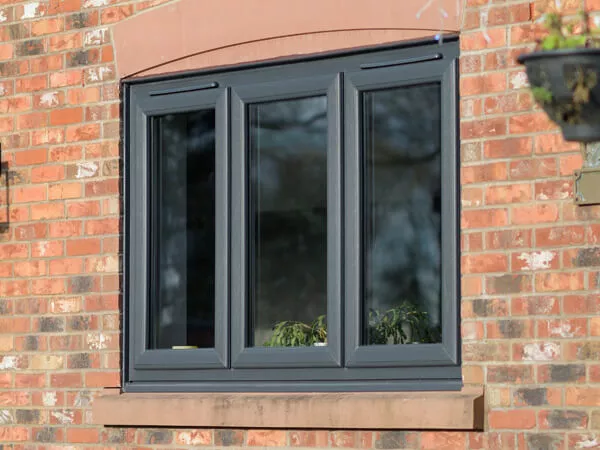
- Features
The side hinge of the casement engineers an outward opening, yours to harness when you wish to entice ventilation and uplift visibility of external vistas. Tightly sealed for optimum thermal efficiency, it is supplemented with tight locking to preserve the safety of home inhabitants. - Best for
Casements suit the architecture of modern abodes and traditional residences, which explains why they’re so prevalent at British homes. - Efficiency Rating
Crucially, the casement window can accomplish impressive feats of energy efficiency, but on the assumption that it is tightly sealed when closed and utilises insulating materials and double or triple glazing. - Design Options
UPVC, aluminium and timber are the pre-eminent materials employed in their crafting, forged into traditional, modern and heritage styles. Colour possibilities cover most parts of the spectrum, including wood effects. - *Average Cost
Price will be dictated by the required window sizes, plus the chosen material and glazing, as well as any required customised touches. ⭐ ⭐ ⭐
Sash Window
Sash windows rose to prominence in the latter part of the 17th century, during the time of the Georgian and Victorian eras.
Back then, they boasted timber-built frames, but they’ve evolved over the ensuing years and are nowadays primarily made from UPVC and aluminium profiles, whilst housing larger glass panes than they traditionally did.
Typified by their elegance and boundless charm, sash windows are opened and closed with a vertical or horizontal slide of their panels.
They remain firmly cemented as one of the leading types of windows almost 400 years on from their entry into the UK.

- Features
Regulate light and airflow by seamlessly sliding the sash/es vertically or horizontally to fashion an opening. A top-line benefit of how it operates is the simplicity of cleaning that it initiates. - Best for
Advocated for owners of modern residences who yearn for their dwelling to display traditional sophistication, but they are also compatible with homes of historical importance. - Efficiency Rating
Sash windows have the capacity to attain medium to high energy efficiency ratings, dependent on having high-performance glazing and thorough insulation. - Design Options
Those who specify the sash style generally get to choose out of UPVC, aluminium and timber profiles and countless hues way beyond just white. Available styles are single-hung, double-hung and sliding. - *Average Cost
Numerous factors will adjudicate the average costing of a sash window, but it usually falls into the mid to high-range financial bracket. ⭐ ⭐ ⭐ ⭐
Tilt and Turn Window
Generally found at homes based in continental Europe, tilt and turn windows are notoriously secure, well-insulating and easy to care for.
They have a very inventive opening mechanism, offering the facility of a slight inward tilt or where you can swing it open, in a similar vein to a traditional door.
The dual functionality of a tilt and turn window comes into its own wherever a homeowner values utmost window flexibility and safety.
Superior practicality sees the tilt and turn window frequently selected for inclusion at contemporary properties, but this immense versatility doesn’t prohibit its addition into older residential buildings.
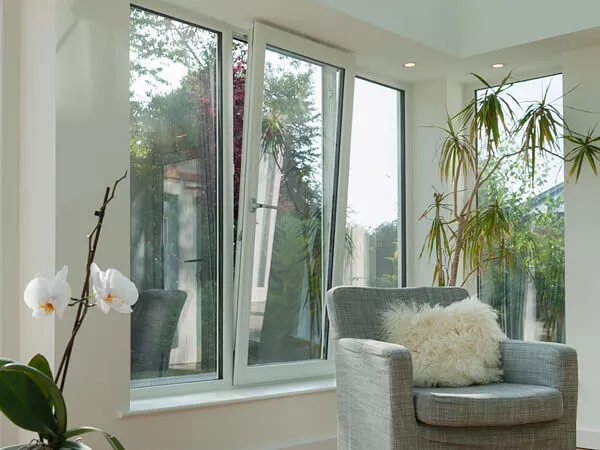
- Features
Operational in one of two ways, you can elect to just partially tilt the window open at the top for a nice airflow or gain full access to the design by swinging it open. Straightforward window cleaning is a key selling-point, rounded off with quality thermal performance. - Best for
Tilt and turns are well-aligned to modern apartment complexes, present-day homes and high-rise buildings. - Efficiency Rating
The family of components i.e. double or triple glazing, multipoint lock, airtight sealing etc., see a tilt and turn easily realise minimum thermal demands. - Design Options
Though you can get aluminium versions, UPVC is principally wielded to produce a tilt and turn window. White, black and Anthracite Grey are just a small sample of potential hues and single-pane, multi-pane, full-height, and floor-to-ceiling designs can be carved. - *Average Cost
Price may prove decisive in whether you pursue tilt and turns as potential replacement windows or not. While sometimes costlier than casements, they can be bought affordably. ⭐ ⭐ ⭐ ⭐
Sliding Window
Think of a sliding window like you would a patio door, as it has sashes that you glide horizontally along a track to orchestrate an opening.
Its movement is just as smooth and because of how it operates, in no way will it infringe on space, which is a useful asset if restricted for room near the designs.
The opening style of sliding windows naturally helps them to attract a generous volume of natural light and ventilation.
Whatever the home setting, sliding windows vow enduring durability and streamlined user efficiency.

- Features
Operating a sliding window involves manoeuvring the design horizontally along its tracking system, so it doesn’t take up valuable space in an open position like some windows do. It’s excellent for ventilating rooms, smoothly operated and a space-saving innovation. - Best for
Sliding windows align well with minimalist modern homes and mid-century properties that advocate horizontal lines and open views. - Efficiency Rating
Generally, a sliding window provides a moderate standard of energy efficiency, however amplified thermal qualities are achievable when double glazed units and insulating frames are involved. - Design Options
Most sliding windows are composed of UPVC or aluminium, single or double-sliders, and parade white, black or grey finishes. - *Average Cost
They can come in under the price range of alternate styles, like casements, but the costing will vary depending on the extent of customisation, window sizes etc. ⭐ ⭐ ⭐
Bay Window
One of the main types of double glazed windows that cannot fail to attract your attention is the bay window, as it noticeably extends out from the wall of a building.
Ordinarily, it has three glazed facets – one large central window with two smaller windows on either side – and these will either be fixed or operable.
Rooms with bay windows feel deceivingly spacious and it’s all down to the added depth and natural light that this style manages to initiate.
Living areas are where a bay window will mostly be seen, modelled into a traditional or modern look, and home occupiers will sometimes place a cushioned bench in the space under the window for sitting on and looking out at the world.
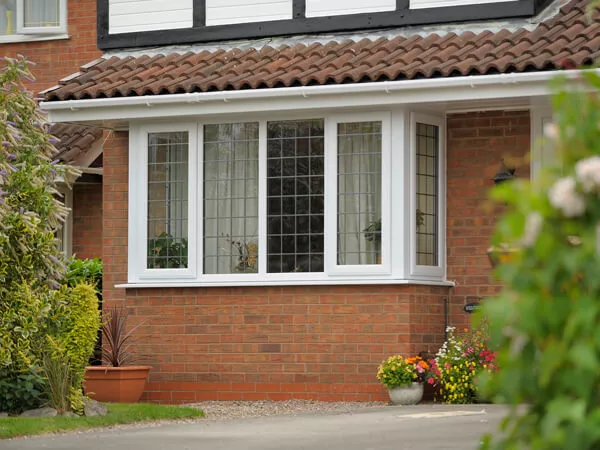
- Features
By projecting out from a house, the bay window enriches an internal space and fosters an improved view. Such a strong focal point, buyer appeal and value will also be raised. - Best for
The existing charm of period properties and Victorian homes will be intensified further upon the addition of a bay window or two. - Efficiency Rating
As they have a large surface area, you are urged to consider energy-efficient glazing to manage heat loss and help bay windows fulfil contemporary thermal necessities. - Design Options
Several materials are used to construct bay windows in both modern and traditional styles, including UPVC, aluminium and wood, with white, cream and woodgrains all being prime colour candidates. - *Average Cost
The number of sections in a bay window will obviously affect the price, rising as you go from a three-section to a five-section bay, as will material and glazing choices. Their complex design also incurs a higher cost than a standard window. ⭐ ⭐ ⭐ ⭐
Bow Window
Bow windows share a similarity with bay windows as they also have a distinctive outward projection, but it’s more of a rounded shape, a bit like an arc.
All the panels are equal-sized and amount to four to six panes that are angled less sharply than a bay window.
Bedrooms, as well as living rooms, are where most bow windows tend to be situated and they do a similar thing to the bay window, in that they magnify light gain and nurture panoramic views.
Constructed from UPVC, aluminium or timber, a bow window makes for a stunning centrepiece in any home architecture.
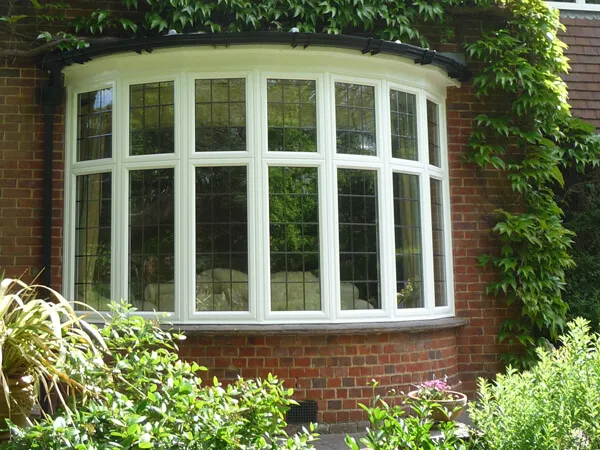
- Features
The multi-panelled bow window has a fixed or partially operable design with a graceful curve, cultivating a brightened home living environment for occupants. - Best for
Suited to period homes, Victorian-style properties and deluxe modern homesteads for first-rate finesse and intensified natural light. - Efficiency Rating
With effective sealing, stellar insulation and double or triple glazing, bow windows can manage to realise medium rates of thermal efficiency. - Design Options
Materials like wood, UPVC and aluminium get harnessed for the manufacturing of bow windows in traditional and modern styles. Custom finishes are accessible if white, black and wood tones aren’t harmonious. - *Average Cost
Based on material, glazing, and size, pricing for a bow window can sometimes come in higher than a less complex window design. ⭐ ⭐ ⭐ ⭐
Rooflight/Skylight window
Some call it a rooflight, while some know it is a skylight. However you term this window type, it mostly gets integrated into the roofs or ceilings of loft conversions, extensions etc. to accumulate brightness in light-shy spaces.
When a rooflight/skylight has an opening provision, you can turn to it as a ventilating mechanism.
Toughened or laminated glass inhabits the UPVC or aluminium framework, assuring you of constant insulation and weather resistance.
Apt for new and traditional building styles, the funnelled light brought about by a rooflight or skylight will decrease your dependence on artificial lighting.

- Features
Set into roofs, these fixed or vented windows draw sunlight into living territories, heralding vibrant confines that feel so much roomier than they did previously. - Best for
Employ their use in loft conversions, extensions and modern residences with limited wall window capacity to cajole light into them. - Efficiency Rating
Double or triple glazed rooflights and skylights that are thoroughly insulated provide excellent thermal efficiency, shrinking heat loss and artificial light necessity. - Design Options
There are various rooflight/skylight styles, including fixed, manual, electric opening, flat roof and pitched roof, with their UPVC or aluminium frames typically finished in white, grey or black. - *Average Cost
Prices vary and will also be determined by what kind of rooflight/skylight is requested and its size – the bigger it is, the more the cost goes up. ⭐ ⭐ ⭐ ⭐
Flush Window
We’re used to seeing windows that slightly overhang from a house wall, making a flush window extremely attention-grabbing as a flush frame aligns perfectly with a wall, yielding a sleek, minimalist look.
Ubiquitous at contemporary abodes, the very latest flush windows routinely have energy-efficient glazing and a UPVC profile that closely resembles an authentic wooden frame to mirror the appearance of classic flush openings.
Beautifully streamlined, the flush window enhances light intake and alleviates any risk of water ingress materialising.
Low maintenance requirements dismiss the old trend of wooden flush windows needing frequent care and attention.
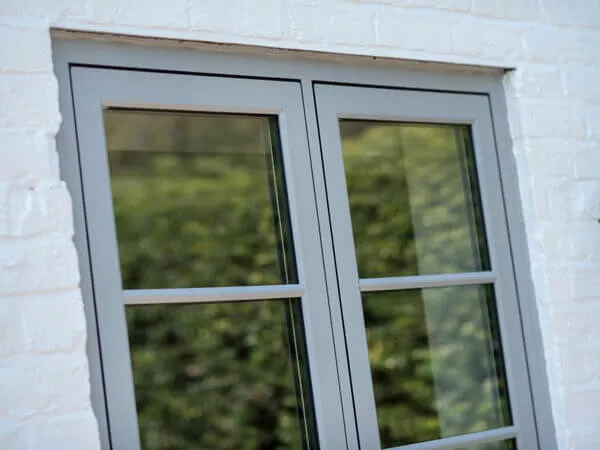
- Features
Flush windows align so seamlessly with exterior walls and in doing so, leave contemporary home architecture looking well-groomed. - Best for
A slick flush window configuration matches modern and period homes if you’re infatuated by the sleekness of it. - Efficiency Rating
In spite of the flush window’s trim framing, it still dispenses highly commendable thermal efficiency if double or triple glazed and sufficiently insulated. - Design Options
In bygone times, flush windows would be wood-built, but most nowadays have UPVC or aluminium frames coated in classic hues, finishes synonymous with flush window creations e.g. Light Oak. - *Average Cost
The magnitude of customisation will contribute to the end cost of flush windows, which are slightly ahead of standard casement windows in the pricing scale. ⭐ ⭐ ⭐ ⭐
Request Your Free Window Quote
Simply fill in your details for your free, no obligation quotation
Which Type of Window Is Best for My House?
The window type deemed the “best” will be whichever style goes nicest with your home’s original character and is suitable for its age, whether it happens to be quite contemporary or goes back centuries.
Look to double glazing windows to be assured of an energy-efficient house that’s free of draughts and doesn’t require a lot of heating in winter.
Security mustn’t be overlooked, so insist on types of house windows that are loaded with secure components, such as a multipoint locking mechanism.
Personal preference obviously also comes into the equation too – you’re going to be living with these designs for a significant period, so you understandably want windows that you will never tire of admiring.
Ultimately, the windows need an equal symmetry of functionality, aesthetics and energy performance.
What Types of Window Frame Are There?
Once they take up occupancy in your window openings, brand-new window frames will majorly define your home’s aesthetic, amongst many other things, also having a resounding impact on durability and energy efficiency.
For residential settings, there are four primary types of window frame you can buy – UPVC, aluminium, composite and timber – which we’ll now individually explain:
- UPVC
Short for unplasticized polyvinyl chloride, UPVC window frames have great thermal credentials and are easily cleaned. Resistant to rotting, fading and corrosion, they are extremely robust and come in an array of styles and colours. - Aluminium
You expect aluminium windows frames to be one of the heaviest window styles, but they’re actually remarkably lightweight, yet uncompromisingly tough. Aluminium’s malleability allows it to be shaped into a broad collection of offerings and it repels weathering. - Composite
Wood, plastic and other materials are bonded together to create a composite window frame, giving you the combined benefits of multiple constituents. Displaying an authentic wood-like appearance, they’re not susceptible to swelling or warping and impressively insulate. - Timber
Timber-built frames have a look all of their own, so natural and with curious lines and contours. A downside when genuine wood is employed to construct timber designs is that regular window preservation will be required, taking the form of staining and repainting.
What Is the Cheapest Style of Window?
As mentioned earlier in the piece, what is the cheapest out of the different types of windows will hinge on what material, glazing and frame type you opt for.
UPVC casement windows come in at a favourable price because of the inexpensiveness of these styles of windows and there will be less outlay needed if you stick to double glazing rather than insist on triple glazing – read up on the topic of triple glazing vs double glazing.
Also, keep in mind when figuring out a budget that the simpler the window style, the less you’ll likely have to pay.
Which window opening types are the best?
Judging what type of window openings to invest in ought to be determined by which will most adhere to any practical needs and aesthetic partialities you have.
Let’s dissect the options once more so that you’re completely up-to-speed with the benefits of each and know what you’ll be getting for your money.
- Casement windows
Open outward as hinged on the side and therefore useful for inviting cool air and natural light inside. - Sash windows
Traditional style that slides vertically or horizontally within the frame, offering a small quantity of ventilation without taking up space internally or externally. - Tilt and Turn windows
Can either be tilted inward at the top or swung inwardly for maximum ventilation and to remove difficulty cleaning the outer pane and frame. - Sliding windows
Encompassing one or more horizontal sliding panels, nurturing intensified airflow while conserving space. - Bay windows
Multi-panelled and extending outward in an angled shape, the bay window is one of the types of windows that adds profound space as it funnels in light. - Bow windows
Exceeds the number of panels in a bay window, but has a similar curvature, which also cajoles light inwards, creating a spacious feel. - Rooflight/Skylight window
Styled into roofs and often present in lofts and rooms with restricted wall space, an operable rooflight or skylight gives you overhead ventilation - Flush windows
Sit perfectly flush within the frame (usually in a casement style), prompting a clean, sleek appearance.
Key Takeaways
We know there’s a lot of information to digest on types of windows for the home, so let’s conclude with a quick summary of some of the main points to remember before we sign off.
On assessing types of house windows, delve into each available style, whether it’s the casement or tilt and turn window, becoming versed with the functionality, benefits, energy efficiency and cost of each.
Also, uncover their compatibility with your home and inspect available frame materials and glazing.
Enjoyed reading this? Maybe move on to studying our piece about how to stop condensation next.
*Price rated from 1-5 stars (1= very low cost, 5= expensive)
Looking for new replacement windows?
Old favourites such as the Sash Window and Casement Window, sit alongside contemporary innovations including our latest flush range available in double glazing or triple glazing options.
REQUEST YOUR FREE QUOTE
Simply fill in your details for your free, no obligation quotation, and click "Get Quote"
Want to speak with an Advisor? Give us a call on 08000 825 825
Our friendly team will be pleased to help with any questions you may have.